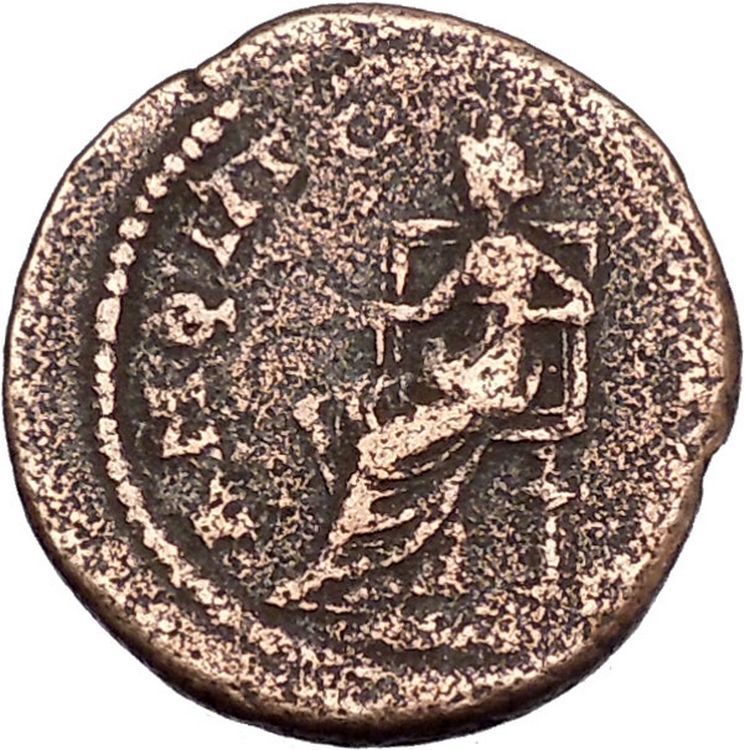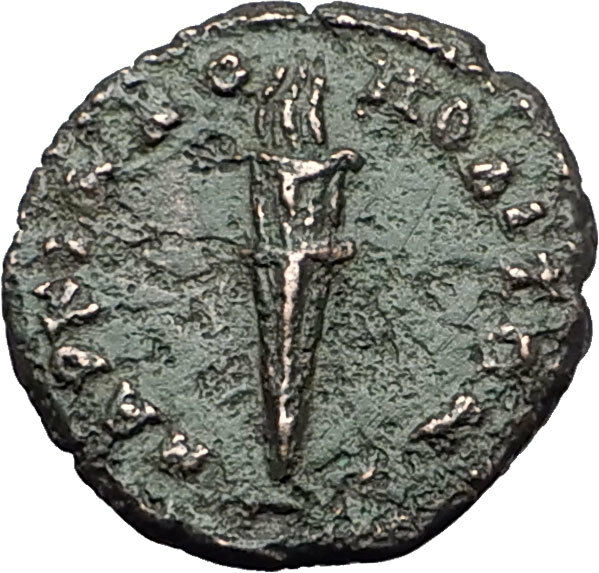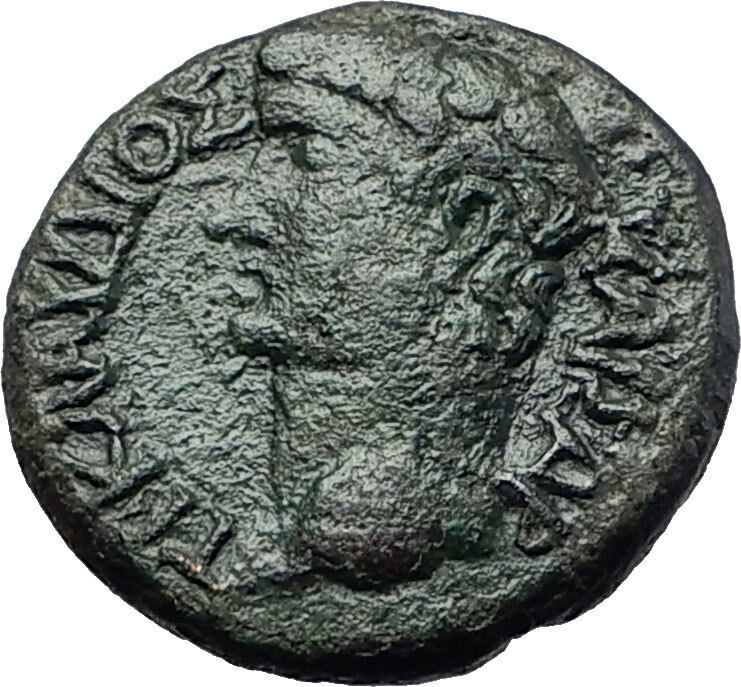|
Septimius Severus – Roman Emperor: 193-211 A.D.
Bronze 21mm (6.04 grams) of Anchialus in Thrace
Laureate head right.
AΓXIAΛЄΩN, Cybele seated left in turreted crown, holding patera & drum, lion next to her.
You are bidding on the exact item pictured, provided with a Certificate of Authenticity and Lifetime Guarantee of Authenticity.
 Cybele (Phrygian: Matar Kubileya/Kubeleya “Kubeleyan Mother”, perhaps “Mountain Mother”; Lydian Kuvava; Greek: Kybele,) was an originally Anatolian mother goddess. Little is known of her oldest Anatolian cults, other than her association with mountains, hawks and lions. She may have been Phrygia’s state deity; her Phrygian cult was adopted and adapted by Greek colonists of Asia Minor and spread from there to mainland Greece and its more distant western colonies from around the 6th century BCE. Cybele (Phrygian: Matar Kubileya/Kubeleya “Kubeleyan Mother”, perhaps “Mountain Mother”; Lydian Kuvava; Greek: Kybele,) was an originally Anatolian mother goddess. Little is known of her oldest Anatolian cults, other than her association with mountains, hawks and lions. She may have been Phrygia’s state deity; her Phrygian cult was adopted and adapted by Greek colonists of Asia Minor and spread from there to mainland Greece and its more distant western colonies from around the 6th century BCE.
In Greece, Cybele met with a mixed reception. She was partially assimilated to aspects of the Earth-goddess Gaia, her Minoan equivalent Rhea, and the Corn-Mother goddess Demeter. Some city-states, notably Athens, evoked her as a protector, but her most celebrated Greek rites and processions show her as an essentially foreign, exotic mystery-goddess who arrives in a lion-drawn chariot to the accompaniment of wild music, wine, and a disorderly, ecstatic following. Uniquely in Greek religion, she had a transgender or eunuch mendicant priesthood. Many of her Greek cults included rites to a divine Phrygian castrate shepherd-consort Attis, who was probably a Greek invention. In Greece, Cybele is associated with mountains, town and city walls, fertile nature, and wild animals, especially lions.
In Rome, Cybele was known as Magna Mater (“Great Mother”). The Roman State adopted and developed a particular form of her cult, and claimed her conscription as a key religious component in their success against Carthage during the Punic Wars. Roman mythographers reinvented her as a Trojan goddess, and thus an ancestral goddess of the Roman people by way of the Trojan prince Aeneas. With Rome’s eventual hegemony over the Mediterranean world, Romanised forms of Cybele’s cults spread throughout the Roman Empire. The meaning and morality of her cults and priesthoods were topics of debate and dispute in Greek and Roman literature, and remain so in modern scholarship.
Pomorie (Bulgarian: Поморие; formerly known as Αγχίαλος Anchialos in Greek, Anchialus in Latin) is a town and seaside resort in southeastern Bulgaria, located on a narrow rocky peninsula in Burgas Bay on the southern Bulgarian Black Sea Coast. It is located in Burgas Province 20 km from Burgas and 18 km from Sunny Beach. The ultrasaline lagoon Lake Pomorie, the northernmost of the Burgas Lakes, lies in the immediate proximity. It is the center of Pomorie Municipality.
Pomorie is an ancient city and today an important tourist destination. As of September 2005 it has a population of 14,600 and the mayor is Petar Zlatanov. It lies at  42°33′N 27°39′E / 42.55°N 27.65°E / 42.55; 27.65. 42°33′N 27°39′E / 42.55°N 27.65°E / 42.55; 27.65.
Possibly founded in the 5th or 4th century BC as a colony of Apollonia (today Sozopol), Anchialos was mentioned in Strabo’s Geographica as a small town. It was briefly captured by Messembria (Nesebar) in the 2nd century BC, but reconquered by Apollonia and its fortified walls destroyed. The name Anchialos is derived from Ancient Greek “anchi-” (“near, close to”) and “als-” (either “salt” or a poetic and uncommon word for “sea”).
The western Black Sea coast was ultimately conquered by the Romans under Marcus Licinius Crassus in 29-28 BC after continuous campaigns in the area since 72-71. The fortified wall was meanwhile rebuilt, as evidenced by Ovid in 9 AD en route to Tomis. In the early 1st century AD Anchialos was the centre of a strategia of the vassal Odrysian kingdom, and the town had a Thracian population in the 6th century AD according to the early Byzantine historian Procopius. As the Odrysian kingdom’s self-independence was abolished in 45 AD, Anchialos became part of the Roman province of Thrace and was formally proclaimed a city under Emperor Trajan. At the time the city controlled a vast territory bordering that of Augusta Trajana (Stara Zagora) and reaching the Tundzha to the west, bordering that of Messembria to the north and the southern shore of Lake Burgas to the south. Anchialos acquired the appearance of a Roman city and thrived considerably in the 2nd and 3rd century under the Severan Dynasty, seving as the most important import and export station of Thrace.
Septimius Severus – Roman Emperor: 193-211 A.D.
 Augustus: 193-211 A.D. | 193-198 A.D. Sole reign; 195-198 A.D. Caracalla as Caesar | 198-209 A.D. with Caracalla; Geta as Caesar | 209-211 A.D. with Caracalla and Geta Augustus: 193-211 A.D. | 193-198 A.D. Sole reign; 195-198 A.D. Caracalla as Caesar | 198-209 A.D. with Caracalla; Geta as Caesar | 209-211 A.D. with Caracalla and Geta
Husband of Julia Domna | Father of Caracalla and Geta | Uncle of Julia Soaemias and Julia Mamaea | Great-uncle of Elagabalus and Severus Alexander | Brother-in-law of Julia Maesa | Father-in-law of Plautilla |
Lucius Septimius Severus (or rarely Severus I) (April 11, 145/146-February 4, 211) was a Roman general, and Roman Emperor from April 14, 193 to 211. He was born in what is now the Berber part of Rome’s historic Africa Province.
Septimius Severus was born and raised at Leptis Magna (modern Berber, southeast of Carthage, modern Tunisia). Severus came from a wealthy, distinguished family of equestrian rank. Severus was of Italian Roman ancestry on his mother’s side and of Punic or Libyan-Punic ancestry on his father’s. Little is known of his father, Publius Septimius Geta, who held no major political status but had two cousins who served as consuls under emperor Antoninus Pius. His mother, Fulvia Pia’s family moved from Italy to North Africa and was of the Fulvius gens, an ancient and politically influential clan, which was originally of plebeian status. His siblings were a younger Publius Septimius Geta and Septimia Octavilla. Severus’s maternal cousin was Praetorian Guard and consul Gaius Fulvius Plautianus.
In 172, Severus was made a Senator by the then emperor Marcus Aurelius. In 187 he married secondly Julia Domna. In 190 Severus became consul, and in the following year received from the emperor Commodus (successor to Marcus Aurelius) the command of the legions in Pannonia.
On the murder of Pertinax by the troops in 193, they proclaimed Severus Emperor at Carnuntum, whereupon he hurried to Italy. The former emperor, Didius Julianus, was condemned to death by the Senate and killed, and Severus took possession of Rome without opposition.
The legions of Syria, however, had proclaimed Pescennius Niger emperor. At the same time, Severus felt it was reasonable to offer Clodius Albinus, the powerful governor of Britannia who had probably supported Didius against him, the rank of Caesar, which implied some claim to succession. With his rearguard safe, he moved to the East and crushed Niger’s forces at the Battle of Issus. The following year was devoted to suppressing Mesopotamia and other Parthian vassals who had backed Niger. When afterwards Severus declared openly his son Caracalla as successor, Albinus was hailed emperor by his troops and moved to Gallia. Severus, after a short stay in Rome, moved northwards to meet him. On February 19, 197, in the Battle of Lugdunum, with an army of 100,000 men, mostly composed of Illyrian, Moesian and Dacian legions, Severus defeated and killed Clodius Albinus, securing his full control over the Empire.
Emperor
Severus was at heart a soldier, and sought glory through military exploits. In 197 he waged a brief and successful war against the Parthian Empire in retaliation for the support given to Pescennius Niger. The Parthian capital Ctesiphon was sacked by the legions, and the northern half of Mesopotamia was restored to Rome.
His relations with the Roman Senate were never good. He was unpopular with them from the outset, having seized power with the help of the military, and he returned the sentiment. Severus ordered the execution of dozens of Senators on charges of corruption and conspiracy against him, replacing them with his own favorites.
He also disbanded the Praetorian Guard and replaced it with one of his own, made up of 50,000 loyal soldiers mainly camped at Albanum, near Rome (also probably to grant the emperor a kind of centralized reserve). During his reign the number of legions was also increased from 25/30 to 33. He also increased the number of auxiliary corps (numerii), many of these troops coming from the Eastern borders. Additionally the annual wage for a soldier was raised from 300 to 500 denarii.
Although his actions turned Rome into a military dictatorship, he was popular with the citizens of Rome, having stamped out the rampant corruption of Commodus’s reign. When he returned from his victory over the Parthians, he erected the Arch of Septimius Severus in Rome.
According to Cassius Dio, however, after 197 Severus fell heavily under the influence of his Praetorian Prefect, Gaius Fulvius Plautianus, who came to have almost total control of most branches of the imperial administration. Plautianus’s daughter, Fulvia Plautilla, was married to Severus’s son, Caracalla. Plautianus’s excessive power came to an end in 205, when he was denounced by the Emperor’s dying brother and killed. The two following praefecti, including the jurist Aemilius Papinianus, received however even larger powers.
Campaigns in Caledonia (Scotland)
Starting from 208 Severus undertook a number of military actions in Roman Britain, reconstructing Hadrian’s Wall and campaigning in Scotland.
He reached the area of the Moray Firth in his last campaign in Caledonia, as was called Scotland by the Romans.. In 210 obtained a peace with the Picts that lasted practically until the final withdrawal of the Roman legions from Britain, before falling severely ill in Eboracum (York).
Death
He is famously said to have given the advice to his sons: “Be harmonious, enrich the soldiers, and scorn all other men” before he died at Eboracum on February 4, 211. Upon his death in 211, Severus was deified by the Senate and succeeded by his sons, Caracalla and Geta, who were advised by his wife Julia Domna. The stability Severus provided the Empire was soon gone under their reign.
Accomplishments and Record
Though his military expenditure was costly to the empire, Severus was the strong, able ruler that Rome needed at the time. He began a tradition of effective emperors elevated solely by the military. His policy of an expanded and better-rewarded army was criticized by his contemporary Dio Cassius and Herodianus: in particular, they pointed out the increasing burden (in the form of taxes and services) the civilian population had to bear to maintain the new army.
Severus was also distinguished for his buildings. Apart from the triumphal arch in the Roman Forum carrying his full name, he also built the Septizodium in Rome and enriched greatly his native city of Leptis Magna (including another triumphal arch on the occasion of his visit of 203).
Severus and Christianity
Christians were persecuted during the reign of Septimus Severus. Severus allowed the enforcement of policies already long-established, which meant that Roman authorities did not intentionally seek out Christians, but when people were accused of being Christians they could either curse Jesus and make an offering to Roman gods, or be executed. Furthermore, wishing to strengthen the peace by encouraging religious harmony through syncretism, Severus tried to limit the spread of the two quarrelsome groups who refused to yield to syncretism by outlawing conversion to Christianity or Judaism. Individual officials availed themselves of the laws to proceed with rigor against the Christians. Naturally the emperor, with his strict conception of law, did not hinder such partial persecution, which took place in Egypt and the Thebaid, as well as in Africa proconsularis and the East. Christian martyrs were numerous in Alexandria (cf. Clement of Alexandria, Stromata, ii. 20; Eusebius, Church History, V., xxvi., VI., i.). No less severe were the persecutions in Africa, which seem to have begun in 197 or 198 (cf. Tertullian’s Ad martyres), and included the Christians known in the Roman martyrology as the martyrs of Madaura. Probably in 202 or 203 Felicitas and Perpetua suffered for their faith. Persecution again raged for a short time under the proconsul Scapula in 211, especially in Numidia and Mauritania. Later accounts of a Gallic persecution, especially at Lyon, are legendary. In general it may thus be said that the position of the Christians under Septimius Severus was the same as under the Antonines; but the law of this Emperor at least shows clearly that the rescript of Trajan had failed to execute its purpose.
|





 Cybele (Phrygian: Matar Kubileya/Kubeleya “Kubeleyan Mother”, perhaps “Mountain Mother”; Lydian Kuvava; Greek: Kybele,) was an originally Anatolian mother goddess. Little is known of her oldest Anatolian cults, other than her association with mountains, hawks and lions. She may have been Phrygia’s state deity; her Phrygian cult was adopted and adapted by Greek colonists of Asia Minor and spread from there to mainland Greece and its more distant western colonies from around the 6th century BCE.
Cybele (Phrygian: Matar Kubileya/Kubeleya “Kubeleyan Mother”, perhaps “Mountain Mother”; Lydian Kuvava; Greek: Kybele,) was an originally Anatolian mother goddess. Little is known of her oldest Anatolian cults, other than her association with mountains, hawks and lions. She may have been Phrygia’s state deity; her Phrygian cult was adopted and adapted by Greek colonists of Asia Minor and spread from there to mainland Greece and its more distant western colonies from around the 6th century BCE. 42°33′N 27°39′E / 42.55°N 27.65°E / 42.55; 27.65.
42°33′N 27°39′E / 42.55°N 27.65°E / 42.55; 27.65. Augustus: 193-211 A.D. | 193-198 A.D. Sole reign; 195-198 A.D. Caracalla as Caesar | 198-209 A.D. with Caracalla; Geta as Caesar | 209-211 A.D. with Caracalla and Geta
Augustus: 193-211 A.D. | 193-198 A.D. Sole reign; 195-198 A.D. Caracalla as Caesar | 198-209 A.D. with Caracalla; Geta as Caesar | 209-211 A.D. with Caracalla and Geta




